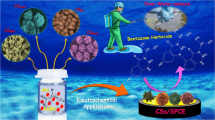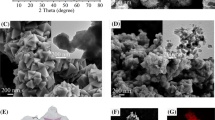Abstract
Three-dimensional porous carbon network (3D-C) was used as the substrate for the in situ growth of molybdenum disulfide (MoS2) through a wet chemistry method. The obtained 3D-C@MoS2 nanocomposite exhibited a porous structure, high surface area and good electrical conductivity. By using the 3D-C@MoS2 nanocomposite as a novel electrode modifier, the electrochemical oxidation peak current of bisphenol A (BPA) was greatly enhanced with a lowered background current. The improved sensitivity benefits from adsorption of BPA onto MoS2 surface, the large surface area and good conductivity of the 3D-C@MoS2 nanohybrid. By using differential pulse voltammetry (DPV), we observed a good linearity with BPA levels in the range of 0.001–10 μM, with a detection limit estimated to be 0.5 nM (S/N = 3). The 3D-C@MoS2 modified electrode could be reused for several times in spite of the accumulation of BPA, and the fabrication reproducibility is excellent. The prepared 3D-C@MoS2 modified electrode showed higher selectivity to BPA than several other phenolic compounds due to their different electrochemical oxidation potentials and the enhanced accumulation property of BPA at the 3D-C@MoS2 surface. The BPA contents in plastic product and environmental water samples were determined with the proposed method.
Graphic abstract








Similar content being viewed by others
Availability of data and material
The datasets generated during and/or analyzed during the current study are available from the corresponding author on reasonable request.
References
Staples CA, Dorn PB, Klecka GM, O’Block ST, Harris LR (1998) A review of the environmental fate, effects, and exposures of bisphenol A. Chemosphere 36(10):2149–2173. https://doi.org/10.1016/S0045-6535(97)10133-3
Biedermann-Brem S, Grob K (2009) Release of bisphenol A from polycarbonate baby bottles: water hardness as the most relevant factor. Eur Food Res Technol 228:679–684. https://doi.org/10.1007/s00217-008-0978-8
Carlsen E, Giwercman A, Keiding N, Skakkebæk NE (1995) Declining semen quality and increasing incidence of testicular cancer: is there a common cause? Environ Health Persp 103:137–139. https://doi.org/10.2307/3432523
Qiao P, Wang X, Gao S, Yin X, Wang Y, Wang P (2020) Integration of black phosphorus and hollow-core anti-resonant fiber enables two-order magnitude enhancement of sensitivity for bisphenol A detection. Biosens Bioelectron 149:111821. https://doi.org/10.1016/j.bios.2019.111821
Owczarek K, Kubica P, Kudłak B, Rutkowska A, Konieczna A, Rachoń D, Namieśnik J, Wasik A (2018) Determination of trace levels of eleven bisphenol A analogues in human blood serum by high performance liquid chromatography-tandem mass spectrometry. Sci Total Environ 628–629:1362–1368. https://doi.org/10.1016/j.scitotenv.2018.02.148
Azzouz A, Rascón AJ, Ballesteros E (2016) Simultaneous determination of parabens, alkylphenols, phenylphenols, bisphenol A and triclosan in human urine, blood and breast milk by continuous solid-phase extraction and gas chromatography–mass spectrometry. J Pharmaceut Biomed 119:16–26. https://doi.org/10.1016/j.jpba.2015.11.024
Cao W, Chao Y, Liu L, Liu Q, Pei M (2014) Flow injection chemiluminescence sensor based on magnetic oil-based surface molecularly imprinted nanoparticles for determination of bisphenol A. Sens Actuators B 204:704–709. https://doi.org/10.1016/j.snb.2014.08.032
Cosio MS, Pellicanò A, Brunetti B, Fuenmayor CA (2017) A simple hydroxylated multi-walled carbon nanotubes modified glassy carbon electrode for rapid amperometric detection of bisphenol A. Sens Actuators B 246:673–679. https://doi.org/10.1016/j.snb.2017.02.104
Shen R, Zhang W, Yuan Y, He G, Chen H (2015) Electrochemical detection of bisphenol A at graphene/melamine nanoparticle-modified glassy carbon electrode. J Appl Electrochem 45:343–352. https://doi.org/10.1007/s10800-015-0792-5
Kong D, Wang H, Cha JJ, Pasta M, Koski KJ, Yao J, Cui Y (2013) Synthesis of MoS2 and MoSe2 films with vertically aligned layers. Nano Lett 13:1341–1347. https://doi.org/10.1021/nl400258t
Lu Y, Yao X, Yin J, Peng G, Cui P, Xu X (2015) MoS2 nanoflowers consisting of nanosheets with a controllable interlayer distance as high-performance lithium ion battery anodes. RSC Adv 5:7938–7943. https://doi.org/10.1039/c4ra14026e
Zhang J, Zhu Z, Feng X (2014) Construction of two-dimensional MoS2/CdS p−n nanohybrids for highly efficient photocatalytic hydrogen evolution. Chem Eur J 20:10632–10635. https://doi.org/10.1002/chem.201402522
Chen Y, Tan C, Zhang H, Wang L (2015) Two-dimensional graphene analogues for biomedical applications. Chem Soc Rev 44:2681–2701. https://doi.org/10.1039/c4cs00300d
Wang T, Zhu H, Zhuo J, Zhu Z, Papakonstantinou P, Lubarsky G, Lin J, Li M (2013) Biosensor based on ultrasmall MoS2 nanoparticles for electrochemical detection of H2O2 released by cells at the nanomolar level. Anal Chem 85:10289–10295. https://doi.org/10.1021/ac402114c
Luo L, Shi M, Zhao S, Tan W, Lin X, Wang H, Jiang F (2019) Hydrothermal synthesis of MoS2 with controllable morphologies and its adsorption properties for bisphenol A. J Saudi Chem Soc 23:762–773. https://doi.org/10.1016/j.jscs.2019.01.005
Gan X, Zhao H, Quan X (2017) Two-dimensional MoS2: a promising building block for biosensors. Biosens Bioelectron 89:56–71. https://doi.org/10.1016/j.bios.2016.03.042
Chao J, Han X, Sun H, Su S, Weng L, Wang L (2016) Platinum nanoparticles supported MoS2 nanosheet for simultaneous detection of dopamine and uric acid. Sci China Chem 59:332–337. https://doi.org/10.1007/s11426-015-5492-9
Ma G, Xu H, Xu F, Wang L (2017) Growth of worm-like and flower-like molybdenum disulfide on graphene nanosheets for sensitive determination of dopamine. Int J Electrochem Sci 12:7365–7376. https://doi.org/10.20964/2017.08.48
Huang K-J, Liu Y-J, Wang H-B, Wang Y-Y, Liu Y-M (2014) Sub-femtomolar DNA detection based on layered molybdenum disulfide/multi-walled carbon nanotube composites, Au nanoparticle and enzyme multiple signal amplification. Biosens Bioelectron 55:195–202. https://doi.org/10.1016/j.bios.2013.11.061
Cao X, Yin Z, Zhang H (2014) Three-dimensional graphene materials: preparation, structures and application in supercapacitors. Energy Environ Sci 7:1850–1865. https://doi.org/10.1039/c4ee00050a
Li Y, Li Z, Shen PK (2013) Simultaneous formation of ultrahigh surface area and three-dimensional hierarchical porous graphene-like networks for fast and highly stable supercapacitors. Adv Mater 25:2474–2480. https://doi.org/10.1002/adma.201205332
Zhou W, Yin Z, Du Y, Huang X, Zeng Z, Fan Z, Liu H, Wang J, Zhang H (2013) Synthesis of few-layer MoS2 nanosheet-coated TiO2 nanobelt heterostructures for enhanced photocatalytic activities. Small 9:140–147. https://doi.org/10.1002/smll.201201161
Chang K, Chen W (2011) l-cysteine-assisted synthesis of layered MoS2/graphene composites with excellent electrochemical performances for lithium ion batteries. ACS Nano 5:4720–4728. https://doi.org/10.1021/nn200659w
Xie J, Zhang J, Li S, Grote F, Zhang X, Zhang H, Wang R, Lei Y, Pan B, Xie Y (2013) Controllable disorder engineering in oxygen-incorporated MoS2 untrathin nanosheets for efficient hydrogen evolution. J Am Chem Soc 135:137881–217888. https://doi.org/10.1021/ja408329q
Chen Z, Cummins D, Reinecke BN, Clark E, Sunkara MK, Jaramillo TF (2011) Core–shell MoO3–MoS2 nanowires for hydrogen evolution: a functional design for electrocatalytic materials. Nano Lett 11:4168–4175. https://doi.org/10.1021/nl2020476
Liang D, Tian Z, Liu J, Ye Y, Wu S, Cai Y, Liang C (2015) MoS2 nanosheets decorated with ultrafine Co3O4 nanoparticles for high-performance electrochemical capacitors. Electrochim Acta 182:376–382. https://doi.org/10.1016/j.electacta.2015.09.085
Ma G, Peng H, Mu J, Huang H, Zhou X, Lei Z (2013) In situ intercalative polymerization of pyrrole in graphene analogue of MoS2 as advanced electrode material in supercapacitor. J Power Sources 229:72–78. https://doi.org/10.1016/j.jpowsour.2012.11.088
Zhan T, Song Y, Li X, Hou W (2016) Electrochemical sensor for bisphenol A based on ionic liquid functionalized Zn–Al layered double hydroxide modified electrode. Mater Sci Eng C 64:354–361. https://doi.org/10.1016/j.msec.2016.03.093
Laviron E (1979) General expression of the linear potential sweep voltammogram in the case of diffusionless electrochemical systems. J Electroanal Chem 101:19–28. https://doi.org/10.1016/S0022-0728(79)80075-3
Huang K-J, Liu Y-J, Liu Y-M, Wang L-L (2014) Molybdenum disulfide nanoflower-chitosan-Au nanoparticles composites based electrochemical sensing platform for bisphenol A determination. J Hazard Mater 276:207–215. https://doi.org/10.1016/j.jhazmat.2014.05.037
Wang M, Shi Y, Zhang Y, Wang Y, Huang H, Zhang J, Song J (2017) Sensitive electrochemical detection of bisphenol A using molybdenum disulfide/Au nanorod composites modified glassy carbon electrode. Electroanalysis 29:2620–2627. https://doi.org/10.1002/elan.201700411
Su B, Shao H, Li N, Chen X, Cai Z, Chen X (2017) A sensitive bisphenol A voltammetric sensor relying on AuPd nanoparticles/graphene composites modified glassy carbon electrode. Talanta 166:126–132. https://doi.org/10.1016/j.talanta.2017.01.049
Pogacean F, Biris AR, Socaci C, Coros M, Magerusan L, Rosu M-C, Lazar MD, Borodi G, Pruneanu S (2016) Graphene–bimetallic nanoparticle composites with enhanced electro-catalytic detection of bisphenol A. Nanotechnology 27:484001. https://doi.org/10.1088/0957-4484/27/48/484001
Messaoud NB, Ghica ME, Dridi C, Ali MB, Brett CMA (2017) Electrochemical sensor based on multiwalled carbon nanotube and gold nanoparticle modified electrode for the sensitive detection of bisphenol A. Sens Actuators B 253:513–522. https://doi.org/10.1016/j.snb.2017.06.160
Li Y, Zhai X, Liu X, Wang L, Liu H, Wang H (2016) Electrochemical determination of bisphenol A at ordered mesoporous carbon modified nano-carbon ionic liquid paste electrode. Talanta 148:362–369. https://doi.org/10.1016/j.talanta.2015.11.010
Niu X, Yang W, Wang G, Ren J, Guo H, Gao J (2013) A novel electrochemical sensor of bisphenol A based on stacked graphene nanofibers/gold nanoparticles composite modified glassy carbon electrode. Electrochim Acta 98:167–175. https://doi.org/10.1016/j.electacta.2013.03.064
Zhou Y, Yang L, Li S, Dang Y (2017) A novel electrochemical sensor for highly sensitive detection of bisphenol A based on the hydrothermal synthesized Na-doped WO3 nanorods. Sens Actuators B 245:238–246. https://doi.org/10.1016/j.snb.2017.01.034
Funding
This work was supported by the National Natural Science Foundation of China (Nos. 52070080, 51478196, 21575043, 21605052).
Author information
Authors and Affiliations
Contributions
Conceptualization: YF, MG; Methodology: YF, FW, MG; Formal analysis and investigation: YF, FW, YL, YF; Writing—original draft preparation: YF; Writing—review and editing: MG, YC, YY; Funding acquisition: MG, YC, YY; Supervision: MG; Revision: LW.
Corresponding author
Ethics declarations
Conflict of interest
The authors of the manuscript have no conflicts of interest to declare.
Additional information
Publisher's Note
Springer Nature remains neutral with regard to jurisdictional claims in published maps and institutional affiliations.
Electronic supplementary material
Below is the link to the electronic supplementary material.
Rights and permissions
About this article
Cite this article
Feng, Y., Wang, F., Wang, L. et al. In situ growth of MoS2 on three-dimensional porous carbon for sensitive electrochemical determination of bisphenol A. J Appl Electrochem 51, 307–316 (2021). https://doi.org/10.1007/s10800-020-01499-w
Received:
Accepted:
Published:
Issue Date:
DOI: https://doi.org/10.1007/s10800-020-01499-w




